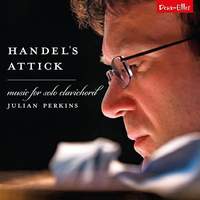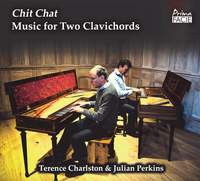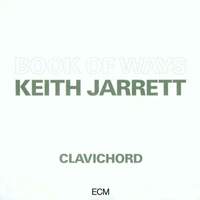Interview,
Julian Perkins explores Handel's Attick

‘‘[Handel] had found means to get a little clavichord privately convey’d to a room at the top of the house. To this room he constantly stole when the family was asleep. He had made some progress before Music had been prohibited, and by his assiduous practice at the hours of rest, had made such farther advances, as, tho’ not attended to at that time, were no slight prognostics of his future greatness.’’
From Memoirs of the Life of the Late George Frederic Handel, 1760, by John Mainwaring
Young Handel’s secret nocturnal sorties to study music in defiance of his father have inspired Handel’s Attick, a solo clavichord recording. The first half comprises pieces by some of the composers that we know Handel studied under Friedrich Wilhelm Zachow in Halle, while the second half (played on a different clavichord) features works that he might have played as an adult in London. Released by Deux-Elles, the recording was Instrumental Choice in the August 2023 issue of BBC Music Magazine.
Alongside performing on the harpsichord, you’ve given a great many recitals on the clavichord, as well as plenty of recordings such as this one. What first drew you to the clavichord?
Its magical sound and simple keyboard mechanism. The clavichord’s softer dynamics encourage musical introspection, while its mechanism gives the player a direct and intimate contact with the strings. Aesthetically, I was also drawn by the instrument’s beauty. How I loved my first encounter with a clavichord, opening its panelled lid to explore the fine grain of its walnut case and letting my hands rest on the keyboard with its ebony naturals and bone accidentals. What secrets could this rectangular box yield?
First, let me explain the mechanics. As can be seen in the video above, the clavichord’s strings go across the instrument, at about ninety degrees to the keyboard. The keys have a brass blade at the business end, called a tangent. When you press a key down, the tangent strikes up against a pair of strings. Unlike the hammer on a piano, the tangent doesn’t bounce off the strings so, like string and wind players, clavichordists are in direct contact with the sound until they release the note. While this gives scope to shape notes and play with a wide range of (lower-level) dynamics, the sensitive action also demands an assured technique. If the hand and mind aren’t fully engaged with the sound, the instrument will answer back with an unforgiving ‘‘chuck’’. It’s great for keeping you match fit!
I also love the wide variety of clavichords as they can show you how to play different styles of music. The two basic flavours are fretted and unfretted. Fretted clavichords have fewer strings because a pair of strings might be shared between two or more tangents, organised so they strike at different points along the strings, thus producing different pitches. Unfretted ones simply have a pair of strings for each tangent. So fretted instruments tend to be smaller than unfretted ones. They’re generally the earlier sort of clavichord. Fretting also makes a difference to the sound, because fewer strings mean less stress on the soundboard, which results in a sparkly sound; while unfretted clavichords tend to have more sustained and velvety sonorities. Adapting my technique to different clavichords is a joyful challenge.
Today, the clavichord is an ideal antidote to my activities as a harpsichordist/fortepianist and conductor/director. As the late clavichordist Joan Benson said, the instrument fosters ‘‘space, a sense of stillness, and a relationship with one’s inner being’’. These are vital elements that can be lost in the adrenaline-filled arena of public performance. It is mainly for these reasons that I love giving clavichord recitals in counterpoint to my other musical activities.
The quiet, unassuming sound of the clavichord made it an appealing (in Handel’s case, even stealthy!) practice instrument in the days before electronic keyboards. Do you think that lack of “oomph” also lies behind its relative obscurity in later periods and up to the present?
There’s an irony here. It is partly because of the clavichord’s lack of ‘‘oomph’’ that it is possibly unique amongst historical keyboards in having been played (almost) continuously since about the fourteenth century. Often portable, inexpensive and tonally stable, the clavichord is the perfect instrument on which to play and study in private. And you can actually get quite a lot of ‘‘oomph’’ on a good clavichord – albeit within a quiet dynamic. Anton Bruckner and Carl Nielsen owned and used clavichords, and present-day performers have even made a case for playing some of Frédéric Chopin’s music on the instrument. 1894 saw Arnold Dolmetsch make four clavichords, his first historical keyboard instruments. More recently, Keith Jarrett played three clavichords in his album Book of Ways, and one features in the sound-mix of For No One by The Beatles.
But it is true that the clavichord continues to be an obscure instrument for many people. Perhaps this is due to the relative rarity of good historical copies today, and because those who have irascible neighbours can now play with headphones at an electronic piano. Yet, as Carl Philipp Emanuel Bach wrote, ‘‘a good clavichordist makes an accomplished harpsichordist, but not the reverse’’. I would say that the clavichord can be a good foundation for all keyboard players. Wouldn’t it be wonderful if it was introduced to all keyboard students, so that they could experience how the technical demands of this musical Cinderella can translate so effectively onto all keyboard instruments? Those filigree ornaments in François Couperin’s harpsichord suites can have both fizz and grace if one has first cultivated a firm yet gentle touch at the seemingly modest clavichord.
Perhaps nothing incites heated debate so much as the word “vibrato” when invoked in the context of early music. How much use do you make of the Bebung technique yourself – and can you tell us a little more about how you actually create vibrato on a keyboard instrument?
Yes, vibrato is a hot potato in so-called early music. It’s perhaps worth reflecting that it is often an ornament that gives life to a note. Like make-up, a little vibrato can go a long way while too much can look cheap! Although a vibrato-less, straight sound can be very effective in some recent music by the likes of Arvo Pärt and John Tavener, it can seem artificial when applied to earlier repertoires as a degree of oscillation is a natural part of tonal production for singers and non-keyboard players. You don’t want to be palpitating on every note, so it’s really a matter of degree.
And a degree of vibrato is what’s possible on the clavichord. This is done by pressing and releasing on a key so that it goes up and down soon or just after playing a note. As you say, this is the Bebung technique, a German word that translates as ‘‘trembling’’. In the late eighteenth century C. P. E. Bach and others even specified it in some of their keyboard pieces by a slur with dots underneath. I like to use Bebung selectively on long notes to bring out singing lines – though I’ve learned to avoid drinking strong coffee before playing, for otherwise I end up trembling on every note!
When András Schiff brought out his album of Bach on the clavichord earlier this year, the sleeve-notes toyed with the idea that the famous “well-tempered keyboard” was actually the newly-developed unfretted clavichord, opening up the full range of keys. Do you think this is likely?
It’s an intriguing idea. The two things were happening at the same time: unfretted clavichords (first made from around the 1710s) were being produced in larger numbers; and, at the same time, tuning systems that moved away from the restrictions imposed by mean-tone were allowing composers to explore more extreme keys. But, as the clavichord maker-scholar Peter Bavington writes, “the word ‘tempered’ (temperirte) refers specifically to tuning, so I think this was what Bach had in mind, rather than any technical developments in the instruments themselves”.
Although the album is focused around Handel and the music he might have played on his own clavichords, I couldn’t help noticing the passing mention of Howells’s two sets of charming miniatures for the instrument, from the twentieth century. How much do you see contemporary composers embracing the clavichord as a sound to explore?
More and more! Although it took a while for contemporary composers to follow Howells’s lead in writing for the clavichord, the performer-scholar Francis Knights estimates that there are currently around 500 contemporary works for the instrument. These include pieces by Louis Andriessen, Stephen Dodgson and Nicola Lefanu – and one in graphic notation by Roman Haubenstock-Ramati.
In terms of exploring the clavichord’s sounds, you can strum and pluck the strings and massage the sound electronically – as is often done with contemporary works for harpsichord and piano. Other effects that are more particular to the clavichord are pitch bending and what I call ‘‘ghosting’’, an effect that is possible on fretted clavichords when you hold down a note silently and then strum the adjacent note(s) that share the same pair of strings. This creates sounds ranging from what seems like a delicate bell to the sonic equivalent of a plague of insects! I hope these various effects appeal to contemporary composers in ways that enhance rather than detract from the clavichord’s integral sound.
I also hope that contemporary composers will write more music for two clavichords. Like London’s buses, recordings often arrive together, and I have also just released a disc of contemporary pieces for two clavichords with Terence Charlston. Entitled Chit Chat, our programme was inspired by Peter Maxwell Davies’s Four Lessons for Two Keyboards (1978). It features eight premières – including pieces by Iain Farrington and Héloïse Werner that we co-commissioned – and concludes with our arrangement of Maxwell Davies’s Farewell to Stromness. For me, it’s nice to think that Maxwell Davies also once played a clavichord in his attic!
Julian Perkins (clavichord)
Available Formats: CD, MP3, FLAC, Hi-Res FLAC
Terence Charlston (clavichord), Julian Perkins (clavichord)
Available Formats: CD, MP3, FLAC, Hi-Res FLAC
Keith Jarrett (clavichord)
Available Formats: 2 CDs, MP3, FLAC





